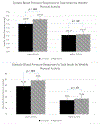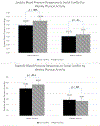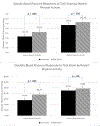Physical activity moderates the effects of daily psychosocial stressors on ambulatory blood pressure
- PMID: 31120273
- PMCID: PMC6746585
- DOI: 10.1037/hea0000755
Physical activity moderates the effects of daily psychosocial stressors on ambulatory blood pressure
Abstract
Objective: Previous literature has shown an inconsistent relationship between physical activity and stressor-evoked blood pressure reactivity. Use of ecological momentary assessment (EMA) may facilitate detecting such a relationship. In this study, the moderating effects of regular physical activity on the magnitude of ambulatory blood pressure (ABP) responses to psychosocial stressors experienced in daily life were examined.
Method: Four hundred seventy-seven healthy working adults (ages 30-54) provided ABP readings and recorded their daily experiences, using electronic diaries (ED), over 4 monitoring days. Measures of momentary Task Strain (high demand, low control) and Social Conflict (rating of recent social interaction quality) were used as indices of stressor exposure, and an accelerometry device was used to create 2 indices of physical activity: weekly average and recent (30 min prior to each ED interview). Multilevel models were used to examine the moderating between- and within-person effects of physical activity on ABP fluctuations corresponding with the momentary psychosocial stressors.
Results: Weekly physical activity moderated the effects of ABP responses to Task Strain (systolic blood pressure [SBP]: p = .033; diastolic blood pressure [DBP]: p = .028) and Social Conflict (DBP: p = .020), with significant increases in SBP and DBP shown for less physically active individuals but not for more physically active individuals. Similarly, recent physical activity moderated within-person DBP responses to Task Strain (p = .025), with greater DBP increases following less active periods.
Conclusion: Our results demonstrate that weekly and recent physical activity may moderate the effects of ABP responses to daily psychosocial stress. (PsycINFO Database Record (c) 2019 APA, all rights reserved).
Conflict of interest statement
Conflicts of Interest: No conflicts of interest were declared.
Figures



Similar articles
-
Ambulatory Blood Pressure Reactivity as a Moderator in the Association Between Daily Life Psychosocial Stress and Carotid Artery Atherosclerosis.Psychosom Med. 2018 Oct;80(8):774-782. doi: 10.1097/PSY.0000000000000627. Psychosom Med. 2018. PMID: 30020145 Free PMC article.
-
Early Life SES, Childhood Trauma Exposures, and Cardiovascular Responses to Daily Life Stressors in Middle-aged Adults.Int J Behav Med. 2023 Dec;30(6):801-813. doi: 10.1007/s12529-022-10141-2. Epub 2022 Nov 22. Int J Behav Med. 2023. PMID: 36417173
-
Psychosocial demands and ambulatory blood pressure: a field assessment approach.Physiol Behav. 2002 Dec;77(4-5):699-704. doi: 10.1016/s0031-9384(02)00921-6. Physiol Behav. 2002. PMID: 12527022 Review.
-
An ambulatory blood pressure monitoring study of the comparative antihypertensive efficacy of two angiotensin II receptor antagonists, irbesartan and valsartan.Blood Press Monit. 2002 Apr;7(2):135-42. doi: 10.1097/00126097-200204000-00008. Blood Press Monit. 2002. PMID: 12048432 Clinical Trial.
-
The aftereffects of dynamic exercise on ambulatory blood pressure.Med Sci Sports Exerc. 2001 Nov;33(11):1855-61. doi: 10.1097/00005768-200111000-00009. Med Sci Sports Exerc. 2001. PMID: 11689735 Review.
Cited by
-
The association between self-reported stress and cardiovascular measures in daily life: A systematic review.PLoS One. 2021 Nov 19;16(11):e0259557. doi: 10.1371/journal.pone.0259557. eCollection 2021. PLoS One. 2021. PMID: 34797835 Free PMC article.
-
Interactions Between Sedentary Behaviour, Moderate-Vigorous Intensity Physical Activity and Acute Psychological Stress-Induced Inflammatory Responses.Stress Health. 2025 Jun;41(3):e70038. doi: 10.1002/smi.70038. Stress Health. 2025. PMID: 40317633 Free PMC article.
-
Physiological reactions to acute stressors and subjective stress during daily life: A systematic review on ecological momentary assessment (EMA) studies.PLoS One. 2022 Jul 27;17(7):e0271996. doi: 10.1371/journal.pone.0271996. eCollection 2022. PLoS One. 2022. PMID: 35895674 Free PMC article.
-
The effect of psychological stress and physical activity on ambulatory blood pressure variability detected by a multisensor ambulatory blood pressure monitoring device.Hypertens Res. 2023 Apr;46(4):916-921. doi: 10.1038/s41440-022-01123-8. Epub 2022 Dec 16. Hypertens Res. 2023. PMID: 36522422 Free PMC article.
-
Feasibility of using ecological momentary assessment to measure the effects of interactions with pet dogs on psychophysiological reactivity in adolescents with social anxiety.Hum Anim Interact. 2023 Jan;2023:10.1079/hai.2023.0036. doi: 10.1079/hai.2023.0036. Epub 2023 Oct 10. Hum Anim Interact. 2023. PMID: 39324061 Free PMC article.
References
-
- Aiken LS, & West SG (1991). Multiple regression: Testing and interpreting interactions. Newbury Park: Sage.
-
- Brownley KA, Hinderliter AL, West SG, Girdler SS, Sherwood A, & Light KC (2003). Sympathoadrenergic mechanisms in reduced hemodynamic stress responses after exercise. Medicine & Science in Sports & Exercise, 35(6), 978–986. - PubMed
-
- Chida Y, & Steptoe A (2010). Greater cardiovascular responses to laboratory mental stress are associated with poor subsequent cardiovascular risk status. Hypertension, 55(4), 1026–1032. - PubMed
MeSH terms
Grants and funding
LinkOut - more resources
Full Text Sources
Medical
Research Materials

